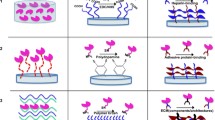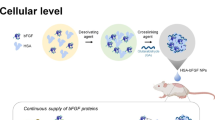Abstract
Controlled delivery of signaling factors could be a great approach in the tissue engineering field. Nano-niosomal drug delivery systems offer numerous advantages for this purpose. The present study reports the formulation and evaluation of a growth factor (GF)-loaded nano-niosome-hydrogel composite for GF delivery to modulate cell behavior. Niosomes were prepared, using span 60 surfactant with cholesterol (CH) in diethyl ether solvent, by reverse-phase evaporation technique. Basic fibroblast growth factor (bFGF) and bovine serum albumin (BSA) were loaded simultaneously and the final suspension was embedded into agarose hydrogel. Particle size, vesicle morphology, protein entrapment efficiency (EE), and release profile were measured by dynamic light scattering (DLS) nanoparticle size analyzer, transmission electron microscopy (TEM) and NanoDrop spectrophotometry methods, respectively. The release and performance of bFGF were revealed via human umbilical vein endothelial cell (HUVEC) proliferation using microscopy imaging and MTT assay. Nano-niosomes had an average particle size of 232 nm and had encapsulated 58% of the total proteins present in the suspension. bFGF-BSA-loaded niosomal gel considerably enhanced HUVEC proliferation. This GF-loaded niosomal hydrogel could be a potent material in many biomedical applications including the induction of angiogenesis in tissue engineering.








Similar content being viewed by others
References
Moghassemi S, Hadjizadeh A. Nano-niosomes as nanoscale drug delivery systems: an illustrated review. J Control Release. 2014;185:22–36.
Verma S, Singh SK, Syan N, Mathur P, Valecha V. Nanoparticle vesicular systems: a versatile tool for drug delivery. J Chem Pharm Res. 2010;2(2):496–509.
Moghassemi S, Parnian E, Hakamivala A, Darzianiazizi M, Vardanjani MM, Kashanian S, et al. Uptake and transport of insulin across intestinal membrane model using trimethyl chitosan coated insulin niosomes. Mater Sci Eng C. 2015;46:333–40.
Madan J, Kaushik D, Sardana S, Mishra D. Effect of ciprofloxacin and chloramphenicol on humoral immune response elicited by bovine albumin encapsulated in niosomes. Acta Pharm Sin. 2007;42(8):905.
Moghassemi S, Hadjizadeh A, Omidfar K. Formulation and characterization of bovine serum albumin-loaded niosome. AAPS PharmSciTech. 2016;1–7.
Tarekegn A, Joseph NM, Palani S, Zacharia A, Ayenew Z. Niosomes in targeted drug delivery: some recent advances. IJPSR. 2010;1(9):1–8.
Carey P, Schneider H, Bernstein H. Raman spectroscopic studies of ligand-protein interactions: the binding of methyl orange by bovine serum albumin. Biochem Biophys Res Commun. 1972;47(3):588–95.
Filová E, Rampichová M, Litvinec A, Držík M, Míčková A, Buzgo M, et al. A cell-free nanofiber composite scaffold regenerated osteochondral defects in miniature pigs. Int J Pharm. 2013;447(1):139–49.
Quinlan E, López‐Noriega A, Thompson EM, Hibbitts A, Cryan SA, O’Brien FJ. Controlled release of vascular endothelial growth factor from spray‐dried alginate microparticles in collagen–hydroxyapatite scaffolds for promoting vascularization and bone repair. J Tissue Eng Regen Med. 2015.
Zhang S, Wang G, Lin X, Chatzinikolaidou M, Jennissen HP, Laub M, et al. Polyethylenimine‐coated albumin nanoparticles for BMP‐2 delivery. Biotechnol Prog. 2008;24(4):945–56.
Wang G, Siggers K, Zhang S, Jiang H, Xu Z, Zernicke RF, et al. Preparation of BMP-2 containing bovine serum albumin (BSA) nanoparticles stabilized by polymer coating. Pharm Res. 2008;25(12):2896–909.
Das S, Banerjee R, Bellare J. Aspirin loaded albumin nanoparticles by coacervation: implications in drug delivery. Trends Biomater Artif Organs. 2005;18(2):203–12.
Elzoghby AO, Samy WM, Elgindy NA. Albumin-based nanoparticles as potential controlled release drug delivery systems. J Control Release. 2012;157(2):168–82.
Wagner S, Rothweiler F, Anhorn MG, Sauer D, Riemann I, Weiss EC, et al. Enhanced drug targeting by attachment of an anti αv integrin antibody to doxorubicin loaded human serum albumin nanoparticles. Biomaterials. 2010;31(8):2388–98.
Merodio M, Irache JM, Valamanesh F, Mirshahi M. Ocular disposition and tolerance of ganciclovir-loaded albumin nanoparticles after intravitreal injection in rats. Biomaterials. 2002;23(7):1587–94.
Li F-Q, Su H, Wang J, Liu J-Y, Zhu Q-G, Fei Y-B, et al. Preparation and characterization of sodium ferulate entrapped bovine serum albumin nanoparticles for liver targeting. Int J Pharm. 2008;349(1):274–82.
Lu W, Zhang Y, Tan Y-Z, Hu K-L, Jiang X-G, Fu S-K. Cationic albumin-conjugated pegylated nanoparticles as novel drug carrier for brain delivery. J Control Release. 2005;107(3):428–48.
Lu W, Wan J, She Z, Jiang X. Brain delivery property and accelerated blood clearance of cationic albumin conjugated pegylated nanoparticle. J Control Release. 2007;118(1):38–53.
Martina M-S, Nicolas V, Wilhelm C, Ménager C, Barratt G, Lesieur S. The in vitro kinetics of the interactions between PEG-ylated magnetic-fluid-loaded liposomes and macrophages. Biomaterials. 2007;28(28):4143–53.
Lao L, Wang Y, Zhu Y, Zhang Y, Gao C. Poly (lactide-co-glycolide)/hydroxyapatite nanofibrous scaffolds fabricated by electrospinning for bone tissue engineering. J Mater Sci Mater Med. 2011;22(8):1873–84.
Waddad AY, Abbad S, Yu F, Munyendo WL, Wang J, Lv H, et al. Formulation, characterization and pharmacokinetics of Morin hydrate niosomes prepared from various non-ionic surfactants. Int J Pharm. 2013;456(2):446–58.
Awada HK, Johnson NR, Wang Y. Dual delivery of vascular endothelial growth factor and hepatocyte growth factor coacervate displays strong angiogenic effects. Macromol Biosci. 2014;14(5):679–86.
Yang G, Wang J, Li L, Ding S, Zhou S. Electrospun micelles/drug‐loaded nanofibers for time‐programmed multi‐agent release. Macromol Biosci. 2014;14(7):965–76.
Biondi M, Ungaro F, Quaglia F, Netti PA. Controlled drug delivery in tissue engineering. Adv Drug Deliv Rev. 2008;60(2):229–42.
Monteiro N, Martins A, Pires R, Faria S, Fonseca NA, Moreira JN, et al. Immobilization of bioactive factor-loaded liposomes on the surface of electrospun nanofibers targeting tissue engineering. Biomater Sci. 2014;2(9):1195–209.
Watanabe J, Shen H, Akashi M. Polyelectrolyte droplets facilitate versatile layer-by-layer coating for protein loading interface. Acta Biomater. 2008;4(5):1255–62.
Gurrapu A, Jukanti R, Bobbala SR, Kanuganti S, Jeevana JB. Improved oral delivery of valsartan from maltodextrin based proniosome powders. Adv Powder Technol. 2012;23(5):583–90.
Balakrishnan P, Shanmugam S, Lee WS, Lee WM, Kim JO, Oh DH, et al. Formulation and in vitro assessment of minoxidil niosomes for enhanced skin delivery. Int J Pharm. 2009;377(1):1–8.
Firthouse PM, Halith SM, Wahab S, Sirajudeen M, Mohideen SK. Formulation and evaluation of miconazole niosomes. Int J PharmTech Res. 2011;3(2):1019–22.
Li Z, Qu T, Ding C, Ma C, Sun H, Li S, et al. Injectable gelatin derivative hydrogels with sustained vascular endothelial growth factor release for induced angiogenesis. Acta Biomater. 2015;13:88–100.
Acknowledgments
The authors would like to acknowledge the financial support of Iran National Science Foundation (INSF) and Iran Nanotechnology Initiative Council (INIC) for conducting this study.
Author information
Authors and Affiliations
Corresponding author
Additional information
Guest Editors: Jason T. McConville and Javier O. Morales
Rights and permissions
About this article
Cite this article
Moghassemi, S., Hadjizadeh, A., Hakamivala, A. et al. Growth Factor-Loaded Nano-niosomal Gel Formulation and Characterization. AAPS PharmSciTech 18, 34–41 (2017). https://doi.org/10.1208/s12249-016-0579-y
Received:
Accepted:
Published:
Issue Date:
DOI: https://doi.org/10.1208/s12249-016-0579-y




